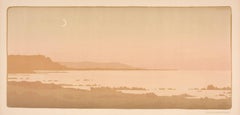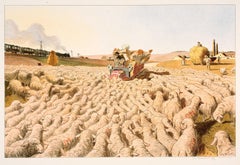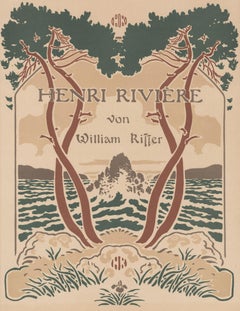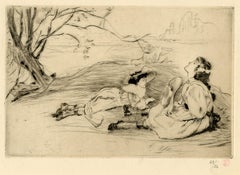Want more images or videos?
Request additional images or videos from the seller
1 of 12
Paul BerthonLa Pointe de Bretteville1899
1899
$350List Price
About the Item
- Creator:Paul Berthon (1872-1909, French)
- Creation Year:1899
- Dimensions:Height: 13.25 in (33.66 cm)Width: 25.63 in (65.11 cm)
- Medium:
- Movement & Style:
- Period:
- Condition:
- Gallery Location:Fairlawn, OH
- Reference Number:Seller: FA11638.31stDibs: LU14015404522
About the Seller
5.0
Recognized Seller
These prestigious sellers are industry leaders and represent the highest echelon for item quality and design.
Gold Seller
Premium sellers maintaining a 4.3+ rating and 24-hour response times
Established in 1978
1stDibs seller since 2013
835 sales on 1stDibs
Associations
International Fine Print Dealers Association
Authenticity Guarantee
In the unlikely event there’s an issue with an item’s authenticity, contact us within 1 year for a full refund. DetailsMoney-Back Guarantee
If your item is not as described, is damaged in transit, or does not arrive, contact us within 7 days for a full refund. Details24-Hour Cancellation
You have a 24-hour grace period in which to reconsider your purchase, with no questions asked.Vetted Professional Sellers
Our world-class sellers must adhere to strict standards for service and quality, maintaining the integrity of our listings.Price-Match Guarantee
If you find that a seller listed the same item for a lower price elsewhere, we’ll match it.Trusted Global Delivery
Our best-in-class carrier network provides specialized shipping options worldwide, including custom delivery.You May Also Like
French architecture house design lithograph, late 19th century, 1878
By Spiegel
Located in Melbourne, Victoria
'Petits Hotels. Boulevard Berthier 45 et 47, a Paris. Elevations, Coupe et Plans, par Mr Boland, Archte.'
French architectural chromolithograph. From 'La Brique Ordinaire', by J Lac...
Category
Late 19th Century Art Nouveau Landscape Prints
Materials
Lithograph
$180
H 16.93 in W 11.82 in
French architecture house design lithograph, late 19th century, 1878
Located in Melbourne, Victoria
'Portes et Murs De Cloture, Avenue d'Aligre, Nos 8 et 10, a Chatou (Seine et Oise), par Mr Eug. Bardon, Archte'.
French architectural chromolithograph. From 'La Brique Ordinaire', b...
Category
Late 19th Century Art Nouveau Landscape Prints
Materials
Lithograph
$180
H 16.93 in W 11.82 in
French architecture house design lithograph, late 19th century, 1878
Located in Melbourne, Victoria
'Ecuries et Remises.'
French architectural chromolithograph. From 'La Brique Ordinaire', by J Lacroux, 1878. A series of fine illustrations of French designs for brick buildings.
...
Category
Late 19th Century Art Nouveau Landscape Prints
Materials
Lithograph
$180
H 16.93 in W 11.82 in
Palais de Glace: A 19th C. Lithograph from Maitres de l'Affiche by Jules Cheret
By Jules Chéret
Located in Alamo, CA
This is a 19th century color lithograph entitled "Palais de Glace, Champs-Elysees" (Ice Palace, Champs-Elysees) created by Jules Cheret and published in 1896 in Paris, France by Cher...
Category
Late 19th Century Art Nouveau Landscape Prints
Materials
Lithograph
$975
H 15.38 in W 11.25 in
Salon des Cents: A 19th C. Lithograph from Maitres de l'Affiche by Feure/Cheret
By Georges De Feure
Located in Alamo, CA
This is a 19th century color lithograph entitled "Expo Salon des Cents" (Salon of the Hundred) created by Georges de Feure and published between 1898 in Paris, France by Jules Cheret...
Category
Late 19th Century Art Nouveau Landscape Prints
Materials
Lithograph
Original Metz vintage lithographic vintage travel poster
Located in Spokane, WA
Original vintage travel poster: METZ (France), artist: Alfred Pellon, signed A. Pellon. Size 34.75" x 36". Year: c 1906. Stone lithograph. ...
Category
Early 1900s Art Nouveau Portrait Prints
Materials
Lithograph
$1,620
H 36 in W 34.75 in D 0.05 in
Original Pointe de Penmarch vintage French travel poster
By ALO (Charles Jean Hallo)
Located in Spokane, WA
Original 1926 Pointe de Penmarch vintage French travel poster, linen-backed, Grade A- condition, ready to frame.
The poster is in very good condition. The right-hand border has a mark along its outer edge, as shown in the images. The mark is about 1.5" long and .75" wide. It is not a paper loss but a stain. Minimal wear for a used poster...
Category
1920s Art Nouveau Landscape Prints
Materials
Lithograph
$1,480 Sale Price
20% Off
H 41 in W 29.25 in D 0.05 in
Original Antar, French Opera Theater vintage stone lithograph opera poster
Located in Spokane, WA
Original vintage French 1921 opera poster: Antar. Artist: Georges Rochegrosse. Stone lithograph linen backed in very fine condtion, ready to frame.
The image features a medie...
Category
1920s Art Nouveau Landscape Prints
Materials
Lithograph
$760 Sale Price
20% Off
H 34.25 in W 26.25 in D 0.05 in
Original Bains de Mer de la Manche - Granville vintage Chemin de Fer poster
By Georges Meunier
Located in Spokane, WA
Original Bains de Mer de la Manche vintage poster. Artist Georges Meunier. Archival linen backed in good condition, ready to frame. Printer: Chaix ...
Category
1920s Art Nouveau Landscape Prints
Materials
Lithograph
$1,850
H 40 in W 28.75 in D 0.05 in
Original Cabourg la plus belle plague vintage French beach poster
By Edouard Elzingre
Located in Spokane, WA
Original poster: CABOURG. "Casino. Grand Hôtel Noël & Pattard, propriétaires du Grand Hôtel à Monte-Carlo".
Caubourg, la plus belle plage. Artist: ...
Category
1890s Art Nouveau Figurative Prints
Materials
Lithograph
$3,080 Sale Price
20% Off
H 63 in W 47 in D 0.05 in
More From This Seller
View AllLa Pointe de Bretteville
By Paul Berthon
Located in Fairlawn, OH
La Pointe de Bretteville
Color lithograph, 1899
Signed in the stone upper right
Publisher: Sagot, Paris
Edition: Edition: about 200 (per Arwas)
References And Exhibitions:
Arwas 33 2...
Category
1890s Art Nouveau Landscape Prints
Materials
Lithograph
Bloques (Road Block)
By Georges Meunier
Located in Fairlawn, OH
Bloques (Road Block)
Color lithograph, 1905
Signed and numbered in pencil lower right; signed and dated in the stone lower right (see photo)
Edition: 100, first edition (33/100)
Publ...
Category
Early 1900s Art Nouveau Landscape Prints
Materials
Lithograph
Cover illustration for Die Graphischen Kunste, Volume 22
By Henri Riviere
Located in Fairlawn, OH
Cover illustration for Die Graphischen Kunste, Volume 22
Color lithograph, 1899
Signed with the artist's initials lower center (see photo)
From: The Graphic Arts, Volume 22, 1899
...
Category
1890s Art Nouveau Landscape Prints
Materials
Lithograph
A L'Ombre (In Shadow)
By Louis Legrand
Located in Fairlawn, OH
A L'Ombre (In Shadow)
Etching & drypoint, 1905
Signed with the red stamp of the publisher Pellet (see photo)
Edition: 50 on velin paper, signed and numbered
Publisher: Gustav Pellet, Paris (his red stamp lower right, recto; Lugt 1193)
Condition: Excellent
Image/Plate size: 5-7/8 x 8-5/8" (14.8 x 21.8 cm.)
Sheet size: 11 5/8 x 17 1/8"
Reference: IFF 119
Exteens 229
Arwas 256 v/V
Louis Auguste Mathieu Legrand (29 September 1863 – 1951) was a French artist, known especially for his aquatint engravings, which were sometimes erotic. He was awarded the Légion d'honneur for his work in 1906.
Life
Legrand was born in the city of Dijon in the east of France. He worked as a bank clerk before deciding to study art part-time at Dijon's Ecole des Beaux-Arts. He won the Devosge prize at the school in 1883.[2] In 1884 Legrand studied engraving under the Belgian printmaker Félicien Rops.
Legrand's artworks include etchings, graphic art and paintings. His paintings featured Parisian social life. Many were of prostitutes, dancers and bar scenes, which featured a sense of eroticism. According to the Hope Gallery, "Louis Legrand is simply one of France's finest early twentieth century masters of etching." His black and white etchings especially provide a sense of decadence; they have been compared to those of Henri de Toulouse-Lautrec, though his drawings of the Moulin Rouge, the can-can dance and the young women of Montmartre preceded Toulouse-Lautrec's paintings of similar scenes. He made over three hundred prints of the night life of Paris. They demonstrate "his remarkable powers of observation and are executed with great skill, delicacy, and an ironic sense of humor that pervades them all."
Two of his satirical artworks caused him to be tried for obscenity. The first, "Prostitution" was a symbolic drawing which depicted a naked girl being grasped by a dark monster which had the face of an old woman and claws on its hands; the second, "Naturalism", showed the French novelist Émile Zola minutely studying the thighs of a woman with a magnifying glass. Defended by his friend the lawyer Eugène Rodrigues-Henriques (1853–1928), he was found not guilty in the lower court, but was convicted in the appeal court and then given a short prison sentence for refusing to pay his fine.
Legrand was made famous by his colour illustrations for Gil Blas magazine's coverage of the can-can, with text by Rodrigues (who wrote under the pseudonym Erastene Ramiro). It was a tremendous success, with the exceptional quantity of 60,000 copies of the magazine being printed and instantly sold out in 1891.
In 1892, at the instigation of the publishing house Dentu, Legrand made a set of etchings of his Gil Blas illustrations. The etchings were published in a book, Le Cours de Danse Fin de Siecle (The End of the Century Dance Classes).
Legrand took a holiday in Brittany, which inspired him to engrave a set of fourteen lithographs of simple country life called Au Cap de la Chevre (On Goat Promontory). It was published by Gustave Pellet who became a close friend of Legrand's. Pellet eventually published a total of 300 etchings by Legrand, who was his first artist; he also published Toulouse-Lautrec and Félicien Rops among others.
He did not only work in graphics; he exhibited paintings at the Paris salon of the Société Nationale des Beaux-Arts starting in 1902. In 1906 he was made a chevalier of the Légion d'honneur.
Legrand died in obscurity in 1951. A retrospective exhibition was held at the Félicien Rops museum in Namur, Belgium in 2006 to celebrate his graphic art. The art collector Victor Arwas published a catalogue raisonné for the occasion.
Books illustrated
de Maupassant, Guy: Cinq Contes Parisiens, 1905.
Poe, Edgar Alan: Quinze Histoires d'Edgar Poe...
Category
Early 1900s Art Nouveau Landscape Prints
Materials
Etching
Saint-Tropez-Le Port
By Paul Signac
Located in Fairlawn, OH
Saint-Tropez-Le Port
Color lithograph, 1897-1898
Signed in pencil lower right (see photo)
Numbered in pencil lower right: No. 68 (see photo)
From: Album des Peintres-Gravures, 1898
...
Category
1890s Post-Impressionist Landscape Prints
Materials
Lithograph
Vue du châteaux de Chenonceaux
Located in Fairlawn, OH
Vue du châteaux de Chenonceaux
Lithograph, 1843
Letterpress signature lower left corner
Signature of the printer lower right corner
After Pierre Justin Ouvrié (1806-1879)
Published b...
Category
1840s Romantic Landscape Prints
Materials
Lithograph



